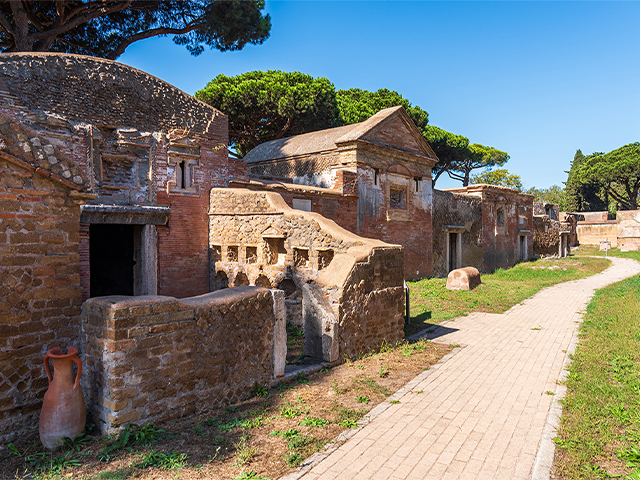Ostia Antica - Archeological Ruins
Discovering the ruins of Ostia Antica: history, curiosities, how to get there and opening times to visit the excavation.The Ruins of Ostia Antica are a fascinating and mysterious timeless place.
To fully understand the greatness of Rome you must pass through here and walk among the remains of what used to be in Imperial times a very important commercial and port city. Thanks to this city born at the mouth of the Tiber (Ostia comes from latin ostium, door) took place an unceasing and invaluable trade with Rome.
Nowadays, the ruins of Ostia Antica are halfway between Rome and Fiumicino, not far from the Leonardo da Vinci Airport or from another relevant archeological site, the Necropolis of Portus, and can be easily reached from Rome and Civitavecchia.
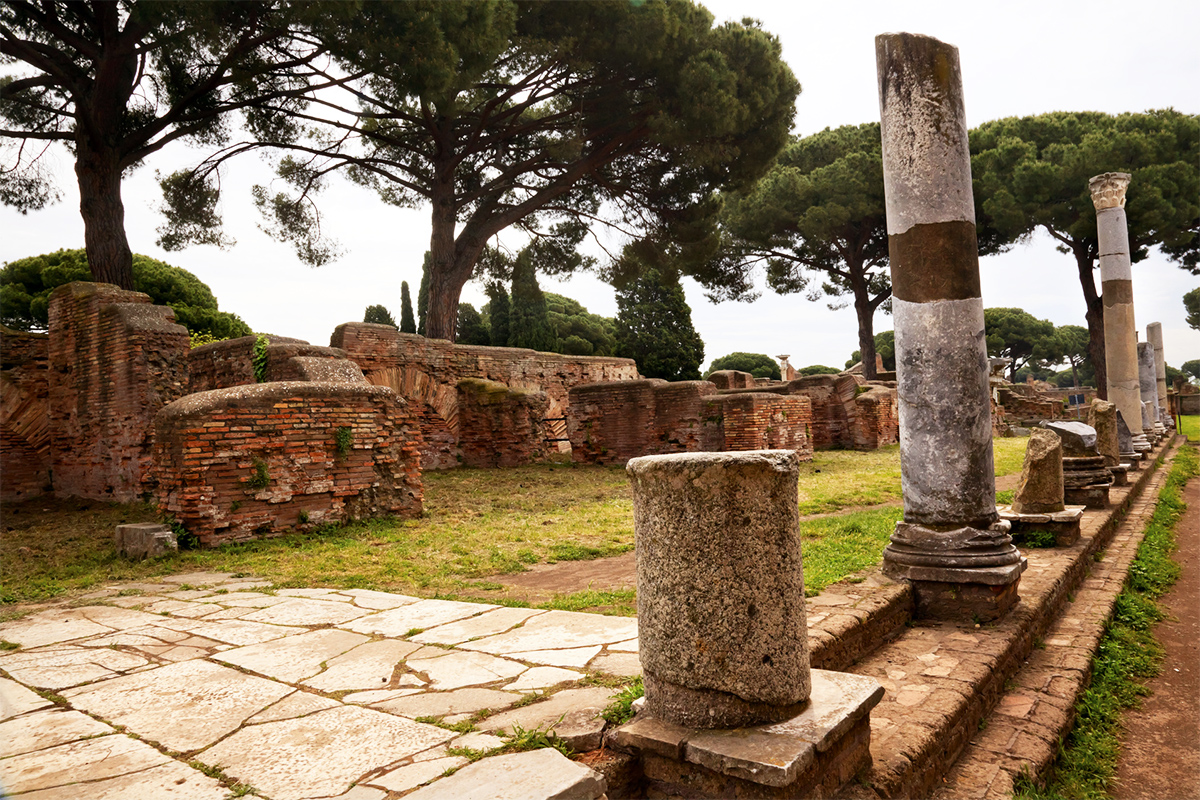
The Ruins of Ostia Antica
The archeological area is really well preserved and, specially in spring, walking among ruins surrounded by flowers and green is a pleasant and relaxing experience. An ideal place for all families with young children, who can have fun here and spend a day outdoors enjoying an environment of freedom and safety!
Therefore, if you love the history of Rome you can't absolutely miss a visit to the ruins of Ostia Antica. Are you curious to find out more? Follow us.
THE RUINS OF OSTIA ANTICA: A LITTLE BIT OF HISTORY
Many legends attribute the foundation of Ostia to the fourth King of Rome Ancus Marcius. This tradition, however, has not been confirmed yet by enough archeological evidence. It is nonetheless true that around the fourth century BC the city was a military encampment, rather, a fortified citadel, in Latin castrum, as can be certified to this day watching the city planning of the ruins.
After the second century BC, when Rome had already reached supremacy over the whole Mediterranean, the militar role of Ostia melted away and the city soon became Rome's river port
In the period of its maximim development, Ostia reached 50,000 inhabitants, but around the third century AD a deep crisis led to a decrease of trade and commerce. Consequently, part of the population left the city. On the meanwhile, emperor Claudius had built further at the North, another port called precisely Portus, standing on the Tyrrhenian coast.
After the fifth century AD there was an economic recovery of the city, both from an economic and a residential point of view. All commercial and administrative activities had definitely been moved to the Port of Trajan, the new port built by the emperor, even further than the Port of Claudius. This artificial port with hexagonal shape was used to guarantee a higher protection against storms and enemy incursions. Since Ostia was really close, it benefited from the commercial point of view.
Even now we can admire all the splendour reached by this city visiting its ruins, valuable evidence of the social and cultural life of the time. Bear with us and we'll take you to discover this rich and prestigious ancient city!
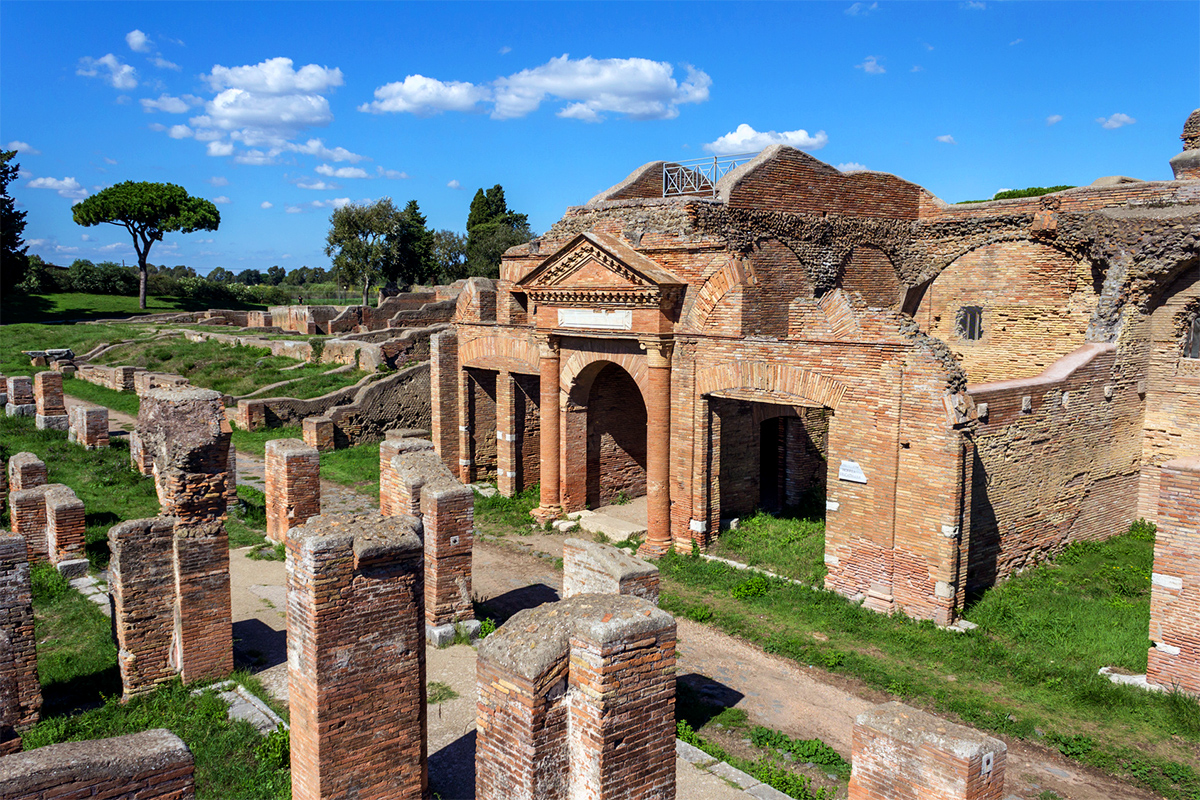
Visiting the ruins of Ostia Antica
ARCHEOLOGICAL AREA AND MAIN ATTRACTIONS
The visit to the ruins of Ostia Antica can start walking through the Decumanus Maximus, the main city road connecting Porta Romana to Porta Marina, leading to a thick network of streets, squares and neighbourhoods that formed the city planning.
You will find buildings, courtyards, storehouses, workshops and thermal baths that have preserved to our day signs and splendid descriptive mosaics.
The northern area of the Decumanus with the Forum of Corporations and the Theater constitute an exceptional evidence of the commercial life of Ostia and Rome in Imperial times.
The whole project dates back to the August period and the Theater, attributed to Agrippa, is a very old building, fully rebuilt with bricks at the end of the second century AD and restored afterwards several times.
Its current capacity is 2,700 seats and it is perfectly feasible, with the orchestra, the cavea, the service corridors and the portico with the tabernae alternated with stairs to reach the terraces.
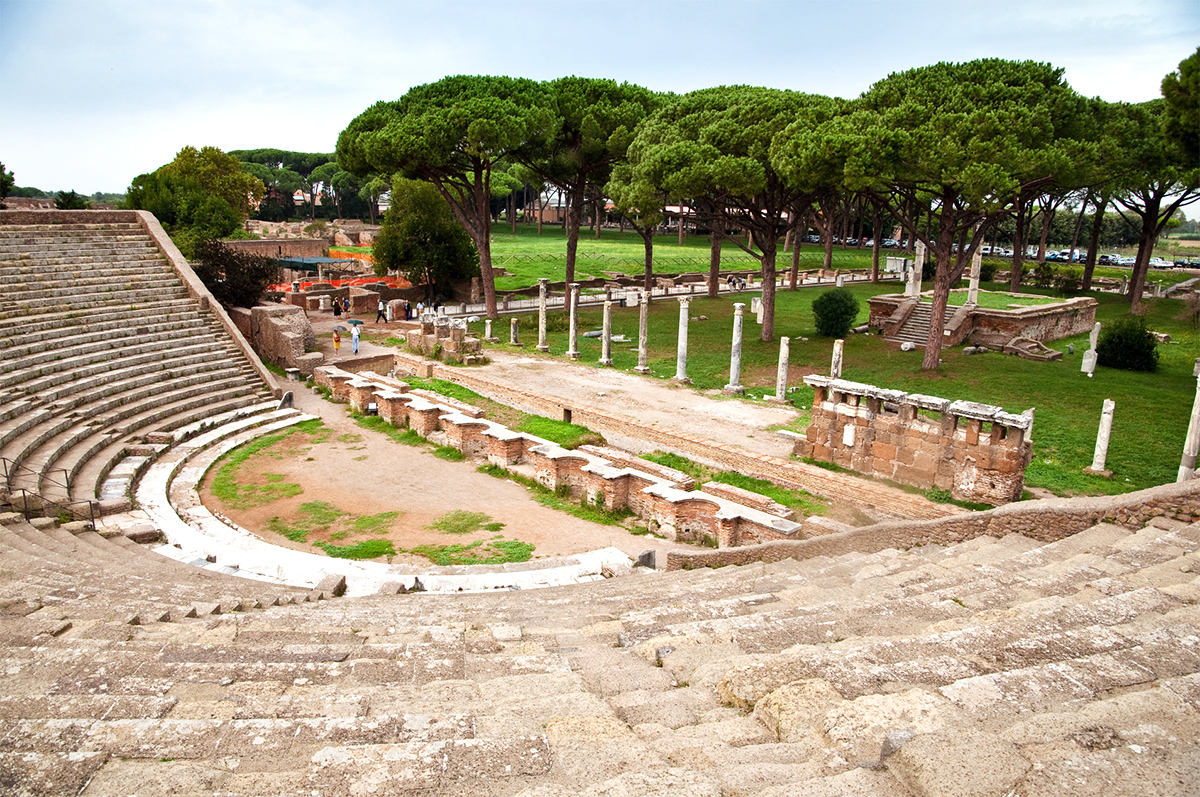
The Theater of Ostia Antica
The big Forum of Corporations, behind the Theater, was originally formed by a simple structure: a huge square, of which has been preserved to our days the moisac floor with an external wall and a covered corridor. Only after, in the age of Claudius, the place was enriched with the portico and it was raised by a second level to house the seats of the collegia, the associations of trades that used to do business there.
The temple, at the center of the square, was built over a podium in the age of Domitian, among gardens and open spaces decorated with statues.
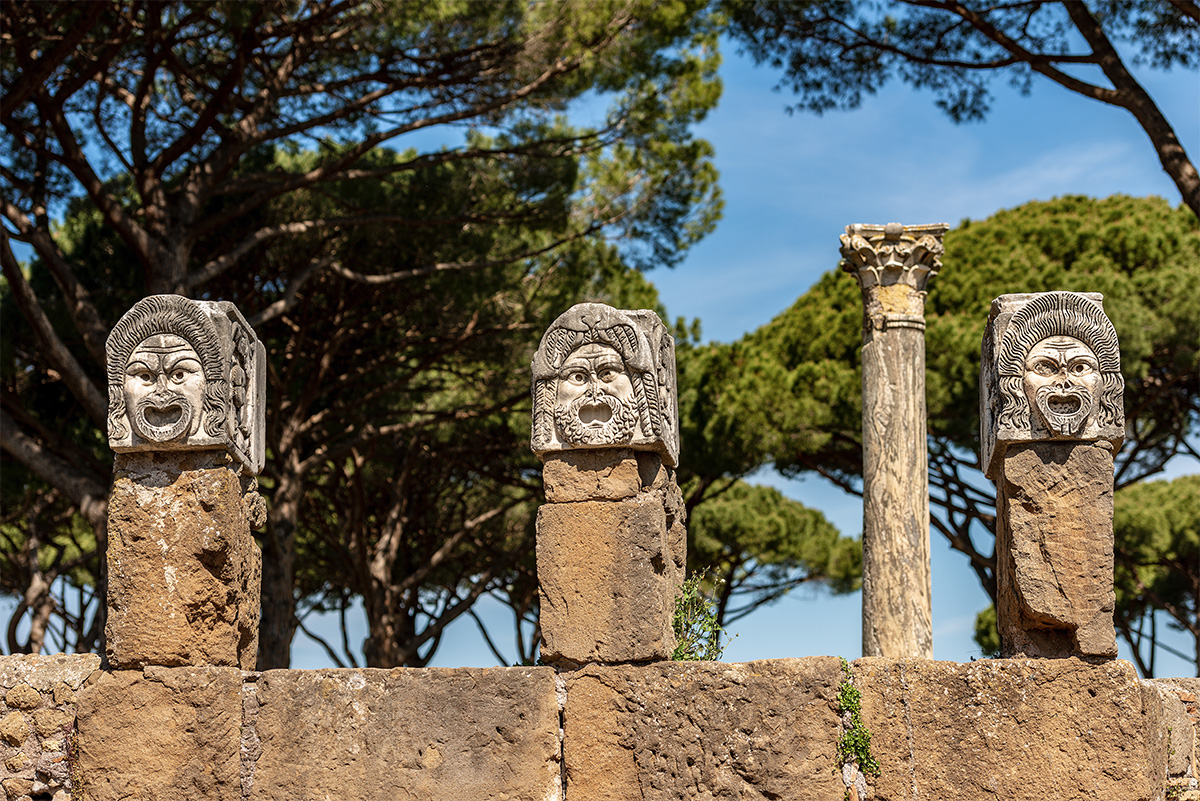
The 3 Masks turned to the stage of the Theater
Among the other interesting buildings to visit, we mention also the Baths of Neptune with nice sea-themed mosaics, the Basilica, the domus of Eros and Psyche, the collegia, the half underground mithraeum, a well preserved tavern with part of the bar and the insule, houses with frescoes that can be visited only upon prior booking.
In addition, within the area there is also a Museum where you can admire statues and other art objects gathered after the excavation works, a cafeteria where you will be able to take a break and a bookshop where you can buy guides, postcards and several gadgets.

The Ruins of Ostia Antica
SOME CURIOSITIES ABOUT OSTIA
Few know that Ostia Antica is absolutely the first Roman colony as well as the biggest Roman city of the ancient world: just think that the Decumanus Maximus is one kilometer and a half long.
Driving your car along the so-called Via del Mare, the arterial road connecting Rome with the Lazio coast, you can't help but appreciate its beauty and remain amazed by its vastity. Actually, continuing along, after a very long straight road, you will get to the modern city of Ostia. The whole city structure, which main hubs are the dock and the roundabout are just a repetition of the city elements present in the ancient Ostia over 2,000 years ago!
Finally, we remind you that the ruins of Ostia are open all first Sundays of every month, when, in addition, admission is free. Read now the information box below to find out about opening times, prices and reservations, to organise your visit at best.
Enjoy your trip!
Useful information
- HOW TO GET THERE
Public transports:
- from the Port of Civitavecchia: to get to the Ruins of Ostia Antica go to Civitavecchia Train Station and get on the first train bound for Rome. After about one-hour trip, get off at Roma Ostiense Station and from there take the first train of the line Roma-Lido di Ostia, from the adjoining station of Porta San Paolo. To get ther you just need to follow the directions inside the station. Get on the train and get off at the stop Ostia Antica: after a 5-minute walk you will be there.
- from Termini Station: take metro line B and get off at Piramide. Get to Porta San Paolo and takethe first train of the line Roma-Lido di Ostia stop Ostia Antica.
- from Fiumicino Airport: once outside the airport, continue along Viale dell'Aeroporto di Fiumicino until crossing Via del Mare and follow the directions to Ostia Antica.- TIMETABLES
- Opening and Closing times throughout the year:- from the last Sunday of October until February 15th: 8:30/15:30 - 16:30- from February 16th until March 15th: 8:30/16:00 - 17:00- from March 16th until the last Saturday of March: 8:30/16:00 - 17:30- from the last Sunday of March until August 31st: 8:30/18:15 - 19:15- from September 1st until 30th: 8:30/18:00 - 19:00- from October 1st until the last Saturday of October: 8:30/17:30 - 18:30Closed: Mondays, December 25th, January 1st, May 1st
- PRICES
- Full ticket: € 10,00Reduced ticket: € 6,00 (18-25 years old and teachers)Free admission: under 18, journalists, school groups; disabled; Students and professors of the faculties of History of Art Architecture, Preservation of Cultural Heritage, archivists, librarians, Accademyof Fine Arts, Educational Science, tourist guides, tourist interpreters (members of the European Comunity) + ICOM members + ICCROM.*the first Sunday of every month admission is free for everybody.For further information and to book your visit, please refer to the official site.



 PORT MOBILITY CIVITAVECCHIA
PORT MOBILITY CIVITAVECCHIA










